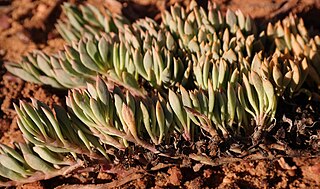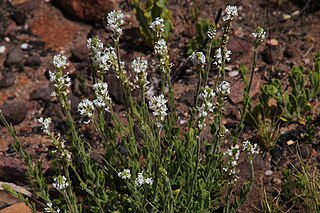
Dimorphotheca pluvialis, common names white African daisy, Cape marigold, weather prophet, Cape rain-daisy, ox-eye daisy, Cape daisy or rain daisy, is a plant species native to South Africa and Namibia. It is sparingly naturalized in scattered locations in California.

Zyrphelis decumbens is a species of perennial plant from the Bainskloof Mountains in the Cape Provinces of South Africa.
Juncus capillaceus is a rush species native to South America, but has been introduced to other parts of the world.

Cyphia bulbosa, also known by its common name Bulb Baroe, is a species of flowering plant from the genus Cyphia.

Ursinia punctata is a species of plant belonging to the daisy family. It is found growing in South Africa, where it has a wide distribution.

Senecio malacitanus, also known as Senecio linifolius is a species of plant from South Africa.

Senecio abruptus, or the yellow starvation ragwort, is a species of plant that is endemic to the Cape Provinces of South Africa.
Acrodon parvifolius, the Botriver tiptoothfig, is a species of mesemb from South Africa. This species, which grows close to the ground, can best be recognised by its small, thin leaves and its flowers, which form a dome in the middle.

Acrosanthes anceps is a species of plant from South Africa.
Cheiridopsis umdausensis is a species of succulent plant from South Africa.
Helichrysum sphaeroideum is a species of flowering plant in family Asteraceae. It is native to the Cape Provinces of South Africa.

Senecio verbascifolius, the mullein ragwort, is a species of plant from South Africa.

Osmitopsis parvifolia is a species of plant from South Africa.
Senecio sophioides is a species of plant from South Africa.

Hebenstretia fastigiosa is a species of plant from South Africa. It belongs to the figwort family.
Hebenstretia glaucescens is a species of plant from South Africa. It belongs to the family Scrophulariaceae.
Hebenstretia hamulosa is a species of plant from South Africa. It belongs to the figwort family.

Hebenstretia lanceolata is a species of plant from South Africa. It belongs to the figwort family.
Hebenstretia minutiflora is a species of plant from South Africa. It belongs to the figwort family.

Heliophila africana, the African sunspurge or little blue mouth, is a species of plant from South Africa.












